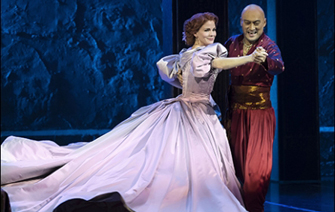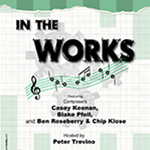The King and I
Vivian Beaumont Theater, NYC, April 23, 2015
Reviewed by Elizabeth Ahlfors for Cabaret Scenes

Photo: Paul Kolnick
Why would the powers that be choose a romantic lead without command of the English language? ‘Tis a puzzlement.
There is something wonderful on so many levels in the opulent revival of The King and I at the Vivian Beaumont Theater. This is a emotional musical drama with a stirring Rodgers and Hammerstein score and a book with heart and scope. A rich cast and orchestra accompany Broadway’s darling, Kelli O’Hara, and her co-star, Ken Watanabe, all gift-wrapped by the seasoned hand of director Bartlett Sher (South Pacific).
Set in 1860, in a spectacular opening scene, gigantic billowing white silks signal a ship sailing on stage and right out into the audience. On board is a widowed schoolteacher, Anna Leonowens (O’Hara), and her young son, Louis (Jake Lucas), traveling to Siam where King Mongkut has hired her to tutor his many children.
https://www.seehowcan.com/wp-content/languages/new/buy-nothing-day-essay.html
She is headed into a world of cultural collisions and changing times.
O’Hara, last seen on Broadway in The Bridges of Madison County, has been nominated five times for a Tony Award. Her portrayal of Anna is warm and feisty, a widow who defends individual rights and needs to support her young son.
https://www.seehowcan.com/wp-content/languages/new/write-my-essay-for-me.html
As the complex King, Watanabe (film The Last Samurai) portrays an impulsive ruler not used to strong, outspoken women, and yet he suddenly finds himself facing a bright educated English woman ready to speak her mind. Problematic is the Japanese-born Watanabe’s command of English, which is a work in progress. His lines and song lyrics are often fuzzy. He has a lot to live up to; unarguably Yul Brynner is still the definitive King. Watanabe, however, has a strong voice and portrays his character with physical grace and effective acting. He puts a lighter, more likeable touch to the monarch, displaying an authoritative yet vulnerable presence, charming the audience and also Anna. He tells her he wants to modernize his country but she realizes his arrogant stubbornness and long-accepted traditions are complications, especially the extremity of male-female roles in Asia. Despite their differences, however, Anna and the King share dignity, mutual admiration, and respect, both realizing the danger of the encroachment of European countries on Asia.
The songs are performed gloriously. O’Hara is at top form, her voice clear and precise. Sweet and winning, she shows her love for the children and with their fascinated mothers, they join her in “Getting to Know You.
https://www.seehowcan.com/wp-content/languages/new/personal-statement-editing.html
” “Hello, Young Lovers” resounds with heartbreaking honesty, recalling the deep love she felt for her late husband, yet, the young lovers themselves, Ashley Park (Tuptim) and Conrad Ricamora (Lun Tha) are less engaging. While exhibiting full-throated passion on the wide stage, their chemistry together is tepid, even delivering songs like “We Kiss in a Shadow” and “I Have Dreamed.”
One high point of the show comes when the King’s first wife, Lady Liang played by Ruthie Ann Miles (Here Lies Love), delivers “Something Wonderful” with profound nuance, inspiring Anna to better understand the monarch.
Based on Jerome Robbins’ original choreography for the 1951 production, choreographer Christopher Gattelli showcases the grace of East and West dance. The suppressed romance, even sexuality, between Anna and the King is apparent in “Shall We Dance,” and builds in exhilaration. Even W.C. Fields might grin as the King’s 11 children greet their new teacher in “March of the Siamese Children” and Gattelli delves into slavery in Siam with his sublime ballet of “The Small House of Uncle Thomas.”
Set designer Michael Yeargan offers enough local characterization for an excursion into the 19th century Far East, with exquisite lighting touches by Donald Holder. Catherine Zuber’s meticulously detailed costumes provide exotic color and sumptuous ambiance. Ted Sperling’s orchestra recalls the lush original orchestrations of Robert Russell Bennett and, from the first downbeat of the musicians, it is obvious that a treat is in store.
Etcetera, Etcetera, Etcetera.





